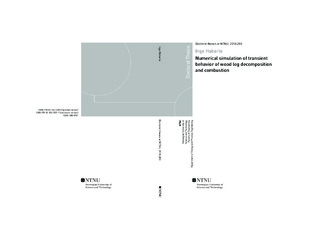| dc.contributor.advisor | Haugen, Nils Erland L. | |
| dc.contributor.advisor | Skreiberg, Øyvind | |
| dc.contributor.author | Haberle, Inge | |
| dc.date.accessioned | 2018-12-18T09:23:18Z | |
| dc.date.available | 2018-12-18T09:23:18Z | |
| dc.date.issued | 2018 | |
| dc.identifier.isbn | 978-82-326-3351-7 | |
| dc.identifier.issn | 1503-8181 | |
| dc.identifier.uri | http://hdl.handle.net/11250/2578034 | |
| dc.description.abstract | Heat from wood combustion in domestic wood stoves is a main contributor to the bioenergy in Norway.
However, wood combustion in such small-scale combustion appliances can cause significant emissions, e.g. fine particulate matter. Therefore, optimization of old technologies and the development of new designs are required in order to manufacture wood stoves with reduced emission levels, higher efficiency and greater ease of use. To perform the required improvements, the combustion process inside the wood stove must be well understood. In the present thesis, thermochemical degradation of wood and successive char conversion were studied numerically by means of one-dimensional (1D) and two-dimensional (2D) models.
Common CFD platforms, e.g. Ansys Fluent, have well-established models for the gas phase, but lack detailed solid phase models. The solid phase model, developed as a standalone code as part of this Ph.D. work, has the potential to be coupled to the gas phase model via user-defined functions in the future. Since processes in the gas and solid phase influence each another, a dynamic coupling of the two models is required to obtain an accurate simulation tool. Fundamental studies on wood combustion can still be done by means of the standalone code. The wood combustion process, implemented in the 1D and the 2D model, included drying, devolatilization and char conversion of the solid fuel. Since all three stages are interrelated, the detailed modeling of all conversion stages with respect to a distinct location inside the wood log had to be done to derive an accurate solid phase combustion model.
The solid conversion model was developed for thermally thick particles, such that wood logs used in fired stoves or boilers could be modeled. Fundamental studies could be performed with the developed one-dimensional (1D) model, while detailed studies on the anisotropy of wood must use the extended two-dimensional (2D) model. Model validation was completed against experimental data, available for thermally thick particles' drying and devolatilization, as well as the combustion of a thermally thick near-spherical particle. The 2D model was validated against experimental data for a large, dry, hanging wood log, due to limited experimental data available on thermochemical degradation and combustion of wood logs, as used in domestic wood stoves.
Presented results include the studies on numerical efficiency of different models, as well as qualitative and quantitative results showing how wood logs degrade under combustion conditions. Furthermore, grid-independence studies were performed as part of the model development in this Ph.D. project. | nb_NO |
| dc.language.iso | eng | nb_NO |
| dc.publisher | NTNU | nb_NO |
| dc.relation.ispartofseries | Doctoral theses at NTNU;2018:280 | |
| dc.relation.haspart | Paper 1: Haberle, Inge; Skreiberg, Øyvind; Lazar, Joanna; Haugen, Nils Erland L. Numerical models for thermochemical degradation of thermally thick woody biomass, and their application in domestic wood heating appliances and grate furnaces. Progress in Energy and Combustion Science 2017 ;Volum 63. s. 204-252
https://doi.org/10.1016/j.pecs.2017.07.004 | nb_NO |
| dc.relation.haspart | Paper 2: Haberle, Inge; Haugen, Nils Erland L; Skreiberg, Øyvind. Drying of Thermally Thick Wood Particles: A Study of the Numerical Efficiency, Accuracy, and Stability of Common Drying Models. Energy & Fuels 2017 ;Volum 31.(12) s. 13743-13760
http://doi.org/10.1021/acs.energyfuels.7b02771 | nb_NO |
| dc.relation.haspart | Paper 3: Haberle, Inge; Haugen, Nils Erland L; Skreiberg, Øyvind. Combustion of Thermally Thick Wood Particles: A Study on the Influence of Wood Particle Size on the Combustion Behavior. Energy & Fuels 2018 ;Volum 32.(6) s. 6847-6862
http://doi.org/10.1021/acs.energyfuels.8b00777 | nb_NO |
| dc.relation.haspart | Paper 4: Haberle, Inge; Haugen, Nils Erland L; Skreiberg, Øyvind. Simulating thermal wood particle conversion: Ash-layer modeling and parametric studies. Energy & Fuels 2018 ;Volum 32.(10) s. 10668-10682
http://doi:org/10.1021/acs.energyfuels.8b02173 | nb_NO |
| dc.relation.haspart | Paper 5: A two-dimensional study on the effect of anisotropy on the devolatilization of a large wood log. | nb_NO |
| dc.title | Numerical simulation of transient behavior of wood log decomposition and combustion | nb_NO |
| dc.type | Doctoral thesis | nb_NO |
| dc.subject.nsi | VDP::Technology: 500::Environmental engineering: 610 | nb_NO |
